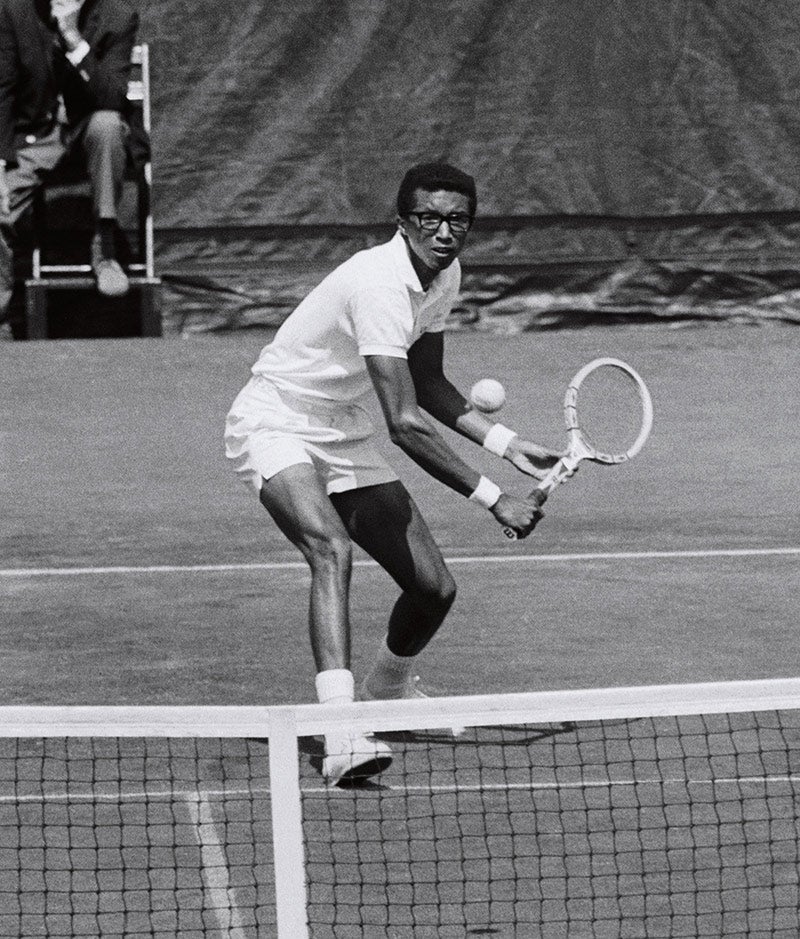
King Arthur’s Court
Two new books celebrate 50 years of the US Open, and the life and legacy of Arthur AsheThe US Open’s Arthur Ashe Stadium is everything Arthur Ashe wasn’t. Whereas Ashe—the first African-American to win a men’s Grand Slam singles title—was dignified, quiet, and composed, the stadium that bears his name is loud, big, and brash. The energy that is just about under control during the day turns the arena into a wild and unpredictable place after dark. But then what can you expect when more than 23,000 New Yorkers come together to watch the rolling drama that is live tennis?
As the actor Alec Baldwin writes in his contribution to the photo-packed coffee-table book, US Open: 50 Years of Championship Tennis, out this month from Abrams, an evening at the Arthur Ashe Stadium is an experience like no other in the sport: “You grab a drink, you grab your seats, and you buckle in.”
And this year, the tournament promises to be even more exhilarating than usual. The summer marks 50 years since the inaugural US Open of the Open Era, in 1968, which enabled amateurs and professionals to compete against each other for the first time (previously the tournament had been known as the US National Championship and was reserved for amateurs). In fact, there is going to be a double celebration: Ashe won the championship that first summer.

To mark the achievement, also out in August is Arthur Ashe: A Life, published by Simon & Schuster. Twenty-five years since Ashe’s death in 1993 from AIDS (which he contracted from a blood transfusion), the civil rights historian Raymond Arsenault chronicles his rich life on and off the court.
In Arsenault, the tennis star found a fitting biographer—scholarly, thoughtful, and thorough. In turn, Arsenault has a formidable subject to work with. Ashe was a human-rights activist, philanthropist, broadcaster, writer, and businessman. Interestingly enough, as Arsenault notes, as a lieutenant in the US Army and registered as an amateur at the time of his win, he wasn’t allowed to collect the $14,000 check. Instead, Ashe received just $280 from a fortnight’s worth of $20 per diem expenses, while the cash prize went to the runner-up, Tom Okker. Clocking in at more than 700 pages, and the product of more than 100 interviews, the volume is a comprehensive study (we don’t recommend lugging it on the subway on the way out to Queens).
While Arsenault’s biography of Ashe is the longest of long-form content—think of it is as the literary equivalent of a five-hour, five-set match—US Open: 50 Years of Championship Tennis offers a collection of dynamic imagery that chronicles the key players through the decades. Starting with a foreword from Serena Williams, and with first-person takes from Baldwin, Chris Evert, and Rod Laver, the book is like the tournament: it knows the power of celebrity.
And though it wasn’t until 1997 that the Arthur Ashe Stadium opened (Ashe would never play in, or even see, the stadium that bears his name), everyone competing there this summer will feel that they are playing on, as Serena Williams describes in her foreword, “truly the biggest stage in tennis.” The rivalry for the most significant prize in the game will undoubtedly be fierce.
Speaking to the larger-than-life feel that the tournament has taken on, at one point in US Open: 50 Years of Championship Tennis, the sportswriter Peter Bodo suggests there is another man who embodies the true spirit of the tournament, namely the “pushy, edgy” John McEnroe. In its rapid transformation during the professional era, maybe the US Open has swapped the spirit of Ashe for the spirit of McEnroe. In the same book, writer Joel Drucker describes how the tournament went from being “an acoustic garden party” to “an electric jungle, a carnival of commotion and sizzling ambition.” Though for all his reserve, you suspect that Ashe himself just might have enjoyed being on that stage.
- Courtesy of Abrams Books






